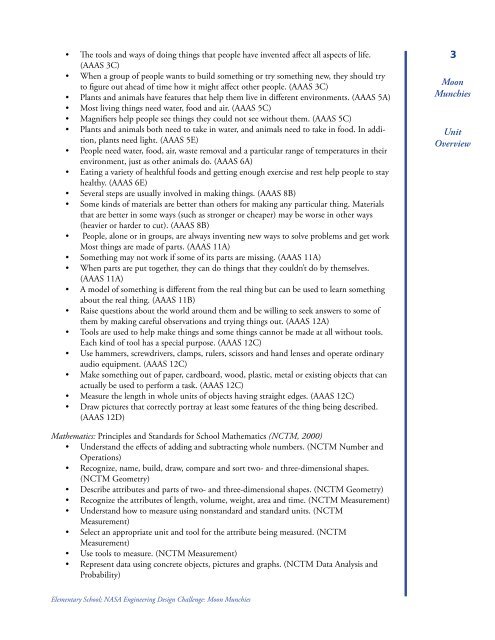Moon Munchies 2 pdf - ER - NASA
Moon Munchies 2 pdf - ER - NASA
Moon Munchies 2 pdf - ER - NASA
You also want an ePaper? Increase the reach of your titles
YUMPU automatically turns print PDFs into web optimized ePapers that Google loves.
• The tools and ways of doing things that people have invented affect all aspects of life.(AAAS 3C)• When a group of people wants to build something or try something new, they should tryto figure out ahead of time how it might affect other people. (AAAS 3C)• Plants and animals have features that help them live in different environments. (AAAS 5A)• Most living things need water, food and air. (AAAS 5C)• Magnifiers help people see things they could not see without them. (AAAS 5C)• Plants and animals both need to take in water, and animals need to take in food. In addition,plants need light. (AAAS 5E)• People need water, food, air, waste removal and a particular range of temperatures in theirenvironment, just as other animals do. (AAAS 6A)• Eating a variety of healthful foods and getting enough exercise and rest help people to stayhealthy. (AAAS 6E)• Several steps are usually involved in making things. (AAAS 8B)• Some kinds of materials are better than others for making any particular thing. Materialsthat are better in some ways (such as stronger or cheaper) may be worse in other ways(heavier or harder to cut). (AAAS 8B)• People, alone or in groups, are always inventing new ways to solve problems and get workMost things are made of parts. (AAAS 11A)• Something may not work if some of its parts are missing. (AAAS 11A)• When parts are put together, they can do things that they couldn’t do by themselves.(AAAS 11A)• A model of something is different from the real thing but can be used to learn somethingabout the real thing. (AAAS 11B)• Raise questions about the world around them and be willing to seek answers to some ofthem by making careful observations and trying things out. (AAAS 12A)• Tools are used to help make things and some things cannot be made at all without tools.Each kind of tool has a special purpose. (AAAS 12C)• Use hammers, screwdrivers, clamps, rulers, scissors and hand lenses and operate ordinaryaudio equipment. (AAAS 12C)• Make something out of paper, cardboard, wood, plastic, metal or existing objects that canactually be used to perform a task. (AAAS 12C)• Measure the length in whole units of objects having straight edges. (AAAS 12C)• Draw pictures that correctly portray at least some features of the thing being described.(AAAS 12D)3<strong>Moon</strong><strong>Munchies</strong>UnitOverviewMathematics: Principles and Standards for School Mathematics (NCTM, 2000)• Understand the effects of adding and subtracting whole numbers. (NCTM Number andOperations)• Recognize, name, build, draw, compare and sort two- and three-dimensional shapes.(NCTM Geometry)• Describe attributes and parts of two- and three-dimensional shapes. (NCTM Geometry)• Recognize the attributes of length, volume, weight, area and time. (NCTM Measurement)• Understand how to measure using nonstandard and standard units. (NCTMMeasurement)• Select an appropriate unit and tool for the attribute being measured. (NCTMMeasurement)• Use tools to measure. (NCTM Measurement)• Represent data using concrete objects, pictures and graphs. (NCTM Data Analysis andProbability)Elementary School; <strong>NASA</strong> Engineering Design Challenge: <strong>Moon</strong> <strong>Munchies</strong>
















